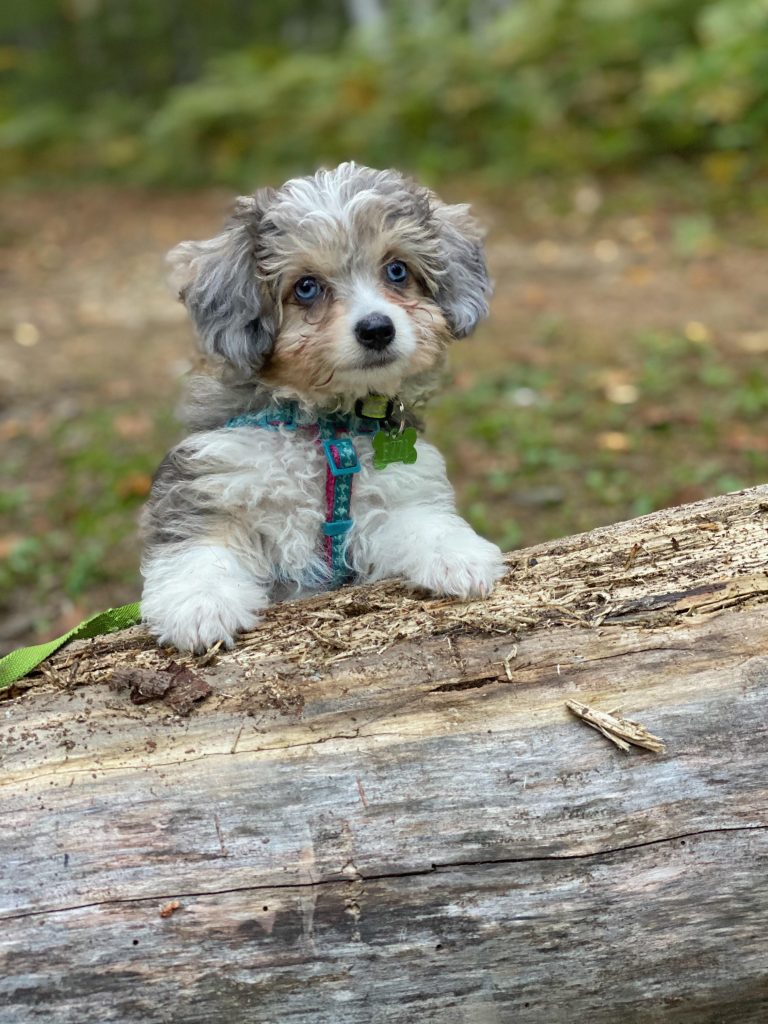
What Is Toy Aussiedoodle?
A Toy Aussiedoodle is a crossbreed dog obtained by crossing a Toy or Miniature Poodle with an Australian Shepherd.
They are known for their friendly, intelligent, and loyal temperament. Toy Aussiedoodles are highly social dogs and enjoy interacting with their owners and other pets.
They are playful and tolerant, making them suitable for multi-pet households. They require regular grooming and exercise to keep them healthy and happy.
The cost of a Toy Aussiedoodle can vary, and they are known for their natural sociability and exceptional compatibility with children and other pets.
What is the average size of a toy aussiedoodle compared to a toy poodle?
The average size of a Toy Aussiedoodle can vary, but they are generally similar in size to a Toy Poodle. Toy Poodles typically stand no more than 10 inches tall and weigh between 4–6 pounds.
Similarly, Toy Aussiedoodles are bred to be small in size, often standing between 10-12 inches tall at the shoulder and weighing between 8-16 pounds.
Therefore, both Toy Aussiedoodles and Toy Poodles are compact and lightweight, making them suitable for various living situations.
Are there any differences in size between toy aussiedoodles and toy poodles?
Toy Aussiedoodles and Toy Poodles are both small dogs, but there can be some differences in their size.
Here’s a comparison of their average sizes:
Toy Aussiedoodles:
- Height: 10-12 inches
- Weight: 6-15 pounds
Toy Poodles:
- Height: 10 inches
- Weight: under 10 pounds
While these sizes are approximate, it’s essential to remember that individual dogs can vary.
Toy Aussiedoodles are a mix of Australian Shepherd and Poodle breeds, and their size can be influenced by the specific breeds used in their lineage.
Toy Poodles, on the other hand, are a separate breed from Aussiedoodles and have a more distinct appearance and temperament.
What is the difference in coat texture between a toy aussiedoodle and a toy poodle?
The coat texture of a Toy Aussiedoodle can vary due to the diverse genetic inheritance from its Poodle and Australian Shepherd parents.
Aussiedoodles, including Toy Aussiedoodles, can inherit a range of coat textures, including fluffy curls from their Poodle parent, a straighter coat from their Australian Shepherd parent, or a wavy texture somewhere in between the two.
While the specific coat texture of a Toy Aussiedoodle may vary, it is generally noted that dogs with curly coats shed less and produce less dander, which can be more suitable for individuals with allergies.
On the other hand, Toy Poodles are known for their distinct curly and dense coat texture, which is a hallmark of the breed.
The coat of a Toy Poodle is dense and curly, and they are often considered a good choice for individuals with allergies due to their minimal shedding and dander.
How often do toy aussiedoodles and toy poodles need to be groomed?
The grooming needs of Toy Aussiedoodles and Toy Poodles can vary depending on their coat type and texture.
Toy Aussiedoodles require regular grooming to keep their coat in good condition, and they should be brushed at least weekly, with professional grooming every 6-8 weeks to manage coat length and prevent matting and overgrowth.
They should be bathed every 4-6 weeks to keep their coat clean and healthy.
Toy Poodles, on the other hand, require daily brushing and regular grooming every 6-8 weeks to keep their coat beautiful and prevent matting and tangling.
They do not shed much, making them an excellent choice for people with allergies.
It is important to note that the grooming needs of individual dogs can vary based on their coat type and texture, and it is essential to consult with a professional groomer or veterinarian to determine the best grooming routine for your dog.
Toy Aussiedoodle Breed
The Toy Aussiedoodle, also known as the Aussiepoo, is an increasingly popular hybrid dog, exhibiting a mix of intelligence and charm. While not officially recognized by the American Kennel Club, the breed’s appeal is strong among dog enthusiasts and pet owners alike.
Insights on the Breed’s Origins
The Toy Aussiedoodle is the offspring of the Australian Shepherd and the Poodle. Understanding these parent breeds offers insights into the Toy Aussiedoodle.
- Australian Shepherd:
- Originating from the USA, known for being protective and reliable.
- Adaptable to various climates and proficient in herding.
- Socially adept, getting along well with children and other animals.
- Energetic and playful, they require physical activity.
- Poodle:
- Noted for their intelligence and active nature.
- Sociable dogs that make excellent family pets.
- Require mental engagement and physical exercise.
- Easily trained and function well as watchdogs.
Deciphering Toy Aussiedoodle Behavior
Salesman to the Toy Aussiedoodle’s intelligence from its parentage, they exhibit a dynamic temperament:
- Well-suited for families and safe around children.
- More reserved due to smaller size but nevertheless active.
- Compatibility with both humans and animals.
Stature and Growth of Toy Aussiedoodles
Toy Aussiedoodles belong to the smallest category within their breed:
- Growth ceases before 12 months, reaching an adult height of around 10 inches.
- Typical weight stands at approximately 15 pounds.
Energy Considerations for Potential Owners
Toy Aussiedoodles inherit remarkable vigor from their progenitors:
- Apt for active individuals or families.
- Needy in terms of mental challenges to remain content.
- Not ideal for sedentary lifestyles.
Grooming Demands of the Double Coat
The double-coated Toy Aussiedoodle necessitates diligent grooming:
- Regular brushing to prevent matting.
- Variety in coat patterns and colors.
- Wise to schedule sessions with a professional groomer.
Importance of Training
Attributed to their keenness to please, training is crucial for these intelligent dogs:
- Rewards such as toys and praise are effective.
- Patience is required as some tricks may take time to learn.
Contemplating Toy Aussiedoodle Ownership
Before deciding on a Toy Aussiedoodle, consider the commitment involved:
- Ensure your lifestyle aligns with the dog’s needs.
- Commit to the necessary time and energy for their care.
Toy Aussiedoodle Size Characteristics
When your Toy Aussiedoodle reaches maturity, you can expect them to stand about 10 to 12 inches in height. They typically attain a weight ranging from 6 to 15 pounds. These diminutive canines typically achieve their full size within their first year of life. Despite their smaller stature relative to larger breeds, Toy Aussiedoodles still require the same level of training and exercise to maintain their health and happiness.
Are toy Aussiedoodles good dogs?
Toy Aussiedoodles inherit the intelligence of their Australian Shepherd and Poodle parents, making them sharp and easy to train.
You’ll find that they thrive in family settings, even those with young children, due to their sociable nature. They may be small and occasionally timid, but don’t let their size fool you; these dogs are lively and enjoy playtime.
Here’s a summary of their qualities:
- Intelligence: High aptitude for learning
- Affinity with Families: Excellent with children and bonds well
- Social Compatibility: Friendly towards other pets
- Activity Level: Energetic, despite being small in stature
Shedding Characteristics of Toy Aussiedoodles
Toy Aussiedoodles are known for being a mixed breed, created by crossing a Toy Poodle with a Miniature Australian Shepherd. They generally inherit a fur quality that falls between their parent breeds, the low-shedding Poodle and the moderate shedding Australian Shepherd.
Shedding Frequency:
- Low to Moderate: They may shed minimally due to their Poodle lineage.
- Seasonal Factors: They might experience a slight increase in shedding with seasonal changes.
Factors Influencing Shedding:
- Genetic Variation: Individual dogs may shed differently depending on which parent’s coat they inherit.
- Health and Nutrition: Proper care and diet can impact the amount of shedding.
Coat Type:
- Usually possesses a wavy to curly coat that may hold onto loose fur, reducing the amount of hair you find around your home.
Managing Shedding:
- Regular Grooming: Brushing a few times a week helps to manage loose fur.
- Professional Grooming: Occasional trips to a groomer for a trim can keep the coat in good condition.
- Diet and Supplements: Ensure a balanced diet with essential fatty acids to promote coat health.
In your search for a pet, if minimal shedding is a priority, a Toy Aussiedoodle may be a suitable option due to their typically low to moderate shedding. Regular grooming can keep any loose hair under control and maintain a healthy coat for your Toy Aussiedoodle. Keep in mind that individual shedding can vary, so you’ll want to consider the specific traits of the dog you choose.
What are the tools needed for grooming toy aussiedoodles and toy poodles
The tools needed for grooming Toy Aussiedoodles and Toy Poodles include:
- Slicker Brush: A high-quality slicker brush is recommended for both breeds to remove tangles and mats. The slicker brush is the number one dog brush recommended by grooming professionals for Aussiedoodles or any Poodle.
- Metal Comb: A metal comb should be used after brushing to ensure thorough detangling. The end result should be the ability to get the comb from the root to the tip of the hair.
- Nail Clippers or Grinder: A nail clipper or grinder is essential for keeping their nails at an appropriate length.
- Clippers: High-quality pet clippers, such as Oster or Wahl, are recommended for at-home grooming, especially for Poodles, which may require regular haircuts.
- Dematting Tool (if needed): A dematting tool can be used as a last resort for removing mats and tangles, especially for Aussiedoodles with thicker coats.
- Grooming Table (optional): A grooming table may be useful for some owners, especially if they are doing more extensive grooming at home.
It’s important to ensure that the tools are of high quality and suitable for the specific coat type and grooming needs of the individual dog.
Additionally, consulting with a professional groomer for guidance on the specific tools and techniques for your dog’s coat can be beneficial.

